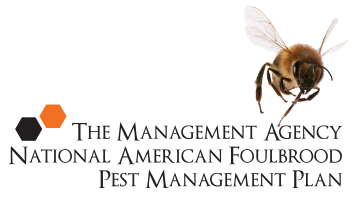Closing hives with AFB
Close the entrance to the hive
The entrance of a diseased hive is normally closed before killing the bees in the colony. Beekeepers usually close the entrance with folded newspaper or long grass stuffed into the entrance. Folded newspaper is preferable, since the bees can sometimes find openings in the grass and will fly out during the killing process. Grass can also sometimes become dislodged during transport, resulting in dead bees falling out onto the ground, or be removed by stock if the hive is left on site.
Seal the cracks
It is also important to seal all the cracks in the hive, since bees will use these cracks to fly out during the killing process. Cracks can be filled by covering with masking tape or by pushing small pieces of newspaper into the cracks with the end of the hive tool.
Best time to destroy the hive
Hives infected with AFB are usually closed and destroyed either in the evening, or during rainy weather, when the bees are not flying. This is done to avoid field bees from the AFB hive flying into neighbouring colonies and possibly spreading the disease.
Because hives infected with AFB are usually found during the daytime, and closed up to be destroyed at night, a second visit to the apiary is generally required. This can create extra costs for the beekeeper, especially when the apiary is a long distance from home.
Although it is preferable for all bees to be inside the AFB infected colony before the entrance is closed and the colony is destroyed, researchers have found that it is possible to kill colonies while the bees are still flying with little risk of spreading the infection.
A trial was conducted pairing colonies with low level infections (i.e., less than 50 larvae/pupae exhibiting AFB symptoms) with colonies not showing any symptoms. At the start of the trial, the pairs of colonies were set up so that their entrances were touching and facing the same way. At the start of the trial, the researchers made sure that one of the colonies had AFB, while the other colony in the pair was uninfected. Then the AFB colony was closed and removed on a sunny day between 1.00pm and 3.00pm, so that foraging field bees from that colony were left behind. The researchers found that most of these field bees flew into the second (no AFB symptoms) colony in the pair.
The trial was repeated with 25 pairs of colonies. Interestingly, none of the colonies remaining behind developed visual symptoms of AFB.
Take the AFB 5 minute quiz
How well do you know what you need to know about AFB and beekeeping? Take our short quiz and find out.
Videos
Our videos cover everything from your legal obligations to how to recognise AFB, collecting cell and bee samples and more.
Symptoms
There’s a lot of good information here, telling you everything you need to know about recognising AFB: the visual symptoms, smell of AFB and more.
Inspection and Diagnosis
Successfully eliminate AFB by telling the difference between symptoms of AFB and other brood diseases in the hive. We tell you the best methods for inspecting your hives.
The Law
New Zealand beekeepers have a number of legal obligations that must be met regarding AFB disease. Read the shortened list in summary, here.
Elimination
Most hives become infected because bees, honey or equipment have been put into a hive from another hive that is infected with AFB. Lower your chances of an AFB infection by reading this section.
AFB Recognition Course Info
Find out when the next AFB Recognition and Competency Courses, or Refresher Courses are available. These are held throughout the year in various New Zealand locations across the South Island and North Island.
The AFB App
Follow the link below to open the App. Once open to save to your device you need to bookmark the URL on your phone so you can find it easily again. Please click here to open.









